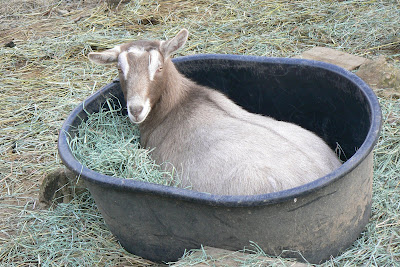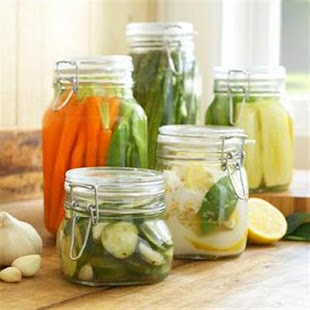
Do you remember my post from last week? The one about the nasty goat's milk we'd been getting from our normally fantastically fresh and sweet milk producer? Well I proceeded to play scientist and start to go through my list of potential taste offenders. Here they were:
1. Checking milk taste now that stainless pails have been sanitized with acid detergent. Also tasting the milk immediately after milking will determine if milking containers, our cooling process, storage jars, or shelf life are affecting the taste.
2. Comparing taste of milking doe's milk to that of other does still with kids to see if the unpleasant taste is there as well indicating that it could be their intake of the different hay. I will also compare the milk taken before feeding in the a.m. to that taken in the p.m. after feeding.
3. Purchasing B vitamins in injectible form to combat any potential deficiency, and reviewing mineral content of their supplement.
4. And lastly, if the taste suddenly dissipates regardless of the above, perhaps residual from the wormer was the cause.
I started at the top of my list and immediately found out that the taste of the milk directly after milking was delicious, just like it always had been. I again milked before feeding and even several hours afterwards. Guess what? The off taste couldn't have anything to do with the hay.
I grabbed some milk from another doe. Her milk was fabulous too. Definitely not the hay.
I went back on-line and checked around for some specific descriptions of the taste I had been experiencing after the milk had been processed and refrigerated for several days. I stumbled across several sites which went way in-depth as to the different off-tastes that milk can take on. This is almost a full-time profession for some it would seem. The best way I could relate the taste of the milk was the equivalent of tasting the smell of tallow. I learned that oxidation of the milk can be a common cause for this taste. I also noticed a small comment. Milk that has been warmed above the temperature of 50 degrees and then recooled can dramatically alter the taste.
Light-bulb moment. I had gotten lazy and had been pouring fresh strained milk into some half-full akreadt cooled quart jars. Guess what I had been doing? Raising the temperature of the milk by pouring in warm milk. Bingo.
1. Checking milk taste now that stainless pails have been sanitized with acid detergent. Also tasting the milk immediately after milking will determine if milking containers, our cooling process, storage jars, or shelf life are affecting the taste.
2. Comparing taste of milking doe's milk to that of other does still with kids to see if the unpleasant taste is there as well indicating that it could be their intake of the different hay. I will also compare the milk taken before feeding in the a.m. to that taken in the p.m. after feeding.
3. Purchasing B vitamins in injectible form to combat any potential deficiency, and reviewing mineral content of their supplement.
4. And lastly, if the taste suddenly dissipates regardless of the above, perhaps residual from the wormer was the cause.
I started at the top of my list and immediately found out that the taste of the milk directly after milking was delicious, just like it always had been. I again milked before feeding and even several hours afterwards. Guess what? The off taste couldn't have anything to do with the hay.
I grabbed some milk from another doe. Her milk was fabulous too. Definitely not the hay.
I went back on-line and checked around for some specific descriptions of the taste I had been experiencing after the milk had been processed and refrigerated for several days. I stumbled across several sites which went way in-depth as to the different off-tastes that milk can take on. This is almost a full-time profession for some it would seem. The best way I could relate the taste of the milk was the equivalent of tasting the smell of tallow. I learned that oxidation of the milk can be a common cause for this taste. I also noticed a small comment. Milk that has been warmed above the temperature of 50 degrees and then recooled can dramatically alter the taste.
Light-bulb moment. I had gotten lazy and had been pouring fresh strained milk into some half-full akreadt cooled quart jars. Guess what I had been doing? Raising the temperature of the milk by pouring in warm milk. Bingo.
Let's face it. Sometimes we get sloppy when we feel it doesn't matter or affect anyone else. If the milk were intended for someone else, I would've never dreamed of treating it so. Why is it that we allow ourselves to take shortcuts when we're well aware of the risks or problematic outcome? Not to get too philosophical here, but it made me do some thinking. Perhaps this experience...that nasty taste will not be soon forgotten...will stick with me long enough to remind me to take care in all areas of my life - family, friends, faith. No more thinking it won't matter or taking the easy way out.







.JPG)
.JPG)
.JPG)
.JPG)
.JPG)
.JPG)

.jpg)





.jpg)



